ASPECTS OF AGRICULTURE IN THE ETON ERA AND SOME FARMING FAMILIES
- ENCLOSURE
- LIVESTOCK
- WATERMEADOWS
- ARABLE
- THE LOVELACE FAMILY
- THE COSH FAMILY
- THE GROVES FAMILY
- THE GREEN FAMILY
- THE DYKE FAMILY
- THE JEANES fAMILY
Throughout the time that Eton College owned Piddlehinton Manor, many detailed surveys of the demesne lands and tenanted copyhold estates reveal that the village community was largely dependent on agriculture.
The family which farmed the demesne lands for Eton and collected the rents from all the other tenants, was the most important in the community. Notable demesne farming families included Harbin, Hyllary, Lowman, Audyn, Kellaway, Meggs, Mayo and Lovelace.
In 1620 an enclosure of part of the demesne land took place (see Church Chapter). At this time Piddlehinton Manor (Population c 216) comprised:
| 1 Demesne Farm | 136 acres arable + common grazing on downs + 2 pieces meadow |
| 20 copyhold tenants | 24 acres arable + common grazing on downs |
| 10 smaller tenants | 12 acres arable + common grazing on downs |
| 16 cottagers | house, garden + common grazing on downs |
| 1 Rector | 40 acres Glebe + common grazing on downs |
Many occupations related to agriculture. These included a "molecatcher" appointed by the manor. Poor members of the community were rewarded by the Churchwardens for catching heads of vermin - " sparros, pollcats, stots, hedgehoggs".
John Beake was a typical mixed farming copyholder of the 17th century. His death in 1664 (at the time of the plague) led to the customary appraisal of his household and farming goods (a money multiplier of 800 brings the valuation roughly up to date):

By 1775 Mr Palmer's estimate of the Yearly Value of the estate, notes that the demesne farm had increased to 219 acres. 18 copyhold tenants had a "whole place" (c24 acres), 16 a "half place" (c12 acres). About 30 cottagers each had a house and garden.
This 1811 map shows the village before it was enclosed.

There are no records of what the people of Piddlehinton thought about the enclosing of the land after 1835, but it must have been a consuming topic of conversation in their homes and ale-houses for many years. No single event, not even the Civil War, had ever affected them as much as would enclosure. For the majority it meant a complete change in their way of life: one can imagine their talk peppered with references to times "afore inclosure". Unlike the earlier enclosure of the demesne farm in 1620 when the rector, the Reverend Thomas Browne, was a vociferous spokesman for Eton's other tenant farmers against the practice, this time the rectors, the Reverend Colson and then Canon Carter, are not recorded as speaking for anyone. Canon Carter was not a popular man as can be seen in the next chapter. So the villagers must have accepted enclosure as inevitable. It is a probability that they were more prepared for the upheaval because the neighbouring village of Piddletrenthide had been enclosed in 1817. Some of them may not have realised the enormity of what was happening until they were denied access to land which they had assumed was theirs by right of usage. In fact, to have a claim to land, the farmer had to produce legal documents proving ownership or tenancy, something the majority of villagers could not do. While the apportionment of land was scrupulously fair according to the law, that same law ignored the rights of the poor.
Over 4000 enclosures took place in England between 1760 and 1845. The Piddlehinton Act was passed in 1830 and the map showing the new field boundaries, with each field's acreage and proprietor, was finally drawn up in 1835. Before enclosure the map was very different: the whole arable area was contained in three large open common fields divided into strips, the other areas being woodland and common grazing. There were 35 copyhold tenants, each with various strips in the arable fields as well as the right to graze one cow and 20 sheep on the common per 10 acres [4.05Ha] of arable land cultivated. The cottagers also had some strips, with limited grazing rights on the common land. Everyone thus had the opportunity to keep at least a pig or a cow and to gather wood or furze for cooking and warmth. Farming had continued in this way for centuries but landowners now recognised the strip system's intrinsic inefficiencies, especially in the light of the new farming machinery and methods which became known as the "Agrarian Revolution". Under the old system experimentation was almost impossible, as there had to be community agreement to anything undertaken in the three arable fields. In the words of the 1830 Act:
"The open and common fields were intermixed, inconveniently situated and incapable of improvement. It was to the great advantage of the Owners or Proprietors if the same were divided and inclosed and specific shares allotted in proportion to the peoples' estates".
Of the 17 interested parties, the 1835 enclosure award shows that only five received enclosed areas, Eton College retaining ownership of much of the parish.
Enclosure was an extremely costly business for landowner and tenant farmer alike. Eton College as landowner had to bring a private Act of Parliament and then pay the Commissioner's and Surveyor's salaries as well as all legal costs incurred. The new fields had to be fenced within a certain time, involving a capital outlay that few farmers could afford. This perhaps explains why only 5 farms were owned privately. The Commissioner appointed by Parliament for the Piddlehinton Enclosure was John Baverstock Knight of West Lodge. He was paid 3 guineas [£3.15] for himself and his clerk for each day employed on the enclosure for the first two years and after that, 2 guineas a day [£2.10] for surveying, measuring, mapping and planning. A percentage of land was "Sale Allotment", that is land sold by the Commissioner to pay for legal costs.
The Rector was allotted glebe and common rights and his tithes, arising from common lands and old enclosures, were not affected by this Act. The Land Act did have several devastating consequences on the life of the poor. It gave the Lords of the Manor the right to the soil of the common and wastelands. Indeed from the time the Commissioner was appointed, which of course was before any enclosure or allotment had taken place, the poor were denied the right to "cut, dig, pare, flay or carry away any turf, sod, furze or fuel" from the commons or waste land without the permission of the Commissioner. If they did, they were liable for a fine of 5 shillings [25p] or the confiscation of their goods. The fines set upon people breaking any of the conditions of the Act were always very heavy. The poor, that is almost half the population, were not in a position to rent any of the new fields from Eton. They also lost the use of the woods and commons which were all enclosed. Thus they had no means to grow food, nowhere to graze an animal and no rights to catch rabbits or gather fuel from the woods. Instead land administered by the Churchwardens and Overseers of the Poor was set aside for the poor to use exclusively. This amounted to one rod [0.25acre or 0.1ha] ) opposite the Poor House in London Row and 4 acres [1.6Ha] of scrubland almost on the extremity of the parish along the Dorchester Road. Some ancient rights of way were stopped by the new fencing. The Commissioner had the power "to change the course of or stop up any carriage roads, footways, bridle-roads, water courses, drains, ditches and bridges".
Many of the poor lost their land and their livelihood. The new fenced fields meant that livestock could not wander so there was no necessity to employ a man or boy to shepherd them all day. Already machines were taking over some of the work: the threshing machine was invented in about 1780 and the reaper in 1826. Some poor lost their homes and became beggars: some moved away to look for work; about a hundred became labourers on the new farms and lived in tied cottages.
As well as the fields, every house and barn was accounted for on the Tithe Apportionment Map of 1838 when all traditional tithe payments were stopped and everyone paid a rent charge in coinage. For instance, the miller had given the rector 1/24th of the corn which he ground: his rent became 1d [0.24p] . Enclosure meant the end of the old traditional farm, the smallholding of between 12 and 24 acres [4.8 and 9.6Ha] spread out in strips in the 3 large fields. It meant the end of co-operation amongst the farmers when everyone agreed when to start the ploughing or the harvest. It meant the end of tithes in kind to the rector. It saw the advent of the tied cottage and it changed the landscape with its pattern of hedges and fences. It is interesting to note that today the larger farmers in the valley are ripping out 18th century and 19th century hedges and returning to the system of very large open fields, not for the re-instatement of strip farming but due to the size of modern machinery.
In 1851, the population of 391 was still dependent on agriculture but by this time the land was divided into 5 major farm holdings of 984, 350, 350, 160, and 120 acres [398, 141, 141, 65 &, 45Ha] and one 20 acre [8Ha] smallholding. This total, 1984 acres [802Ha] , includes the extra land of the parish outside the Piddlehinton manorial holding. The 6 farmers between them employed 104 labourers.
In 1775, the common sheep flock in Piddlehinton Manor numbered 2096. Only 100 other "beasts" - cows and horses were kept. Pigs and poultry were barely noteworthy! (In 1988, the whole parish of Piddlehinton boasted 878+ cattle and 15380 pigs but only 466 sheep!)
In days of manorial farming, it was customary for trespassing stock to be detained in the Manor Pound.
In 1683 the manorial court reported "Wee present that the Lord's pound is all decay'd and wants a new one. To acquaint the Colledge herewith". The Old Pound of Piddlehinton was situated opposite the Manor.
In 1838, the Blacksmith was paid £1/7s [£1.35p] for repairing the Pound and Parish Stocks. In 1842, the surveyor JB Knight reported to Eton that a cottage lifeholder (Sidney Andrews the butcher) had "thrown down" the Old Pound to enlarge his garden. He was outraged that this "ancient symbol and appendage to a Lord of a Manor and his court" had not been preserved. He was also worried that stray animals would cause serious damage. The cottager had thought enclosure in 1835 rendered the Pound obsolete!
A pdf copy of the report can be seen using this link

A New Pound was duly built opposite the churchyard wall. In 1858 the manorial court recorded the Impounding fees as "6d [5p] for a horse, bull or cow, 6d for 20 sheep or less and 3d for every score of sheep after the first". Police Constable 89 ( see Chapter 8) refers to the Pound in his journal on May 8th 1887 as the "New Asylum".
It was bulldozed in 1975, some time after Eton had sold it, to make room for garages.
Amongst the Eton College records, a document dated 1571 states that "The Parson shall provide a bull" for the cattle of Piddlehinton. Other early surveys reveal few cattle were kept until the 19th century. A common cowherd was appointed by the manor; he received a meal from all cattle owners in turn.


Milk, butter and cheese were produced for local consumption by the manor dairy. This was rented by Mr Stephen White in the 19th century, and is now known as Whites Dairy, (photo) with the Thimble Inn adjacent
Eton College was also a customer of the dairy's cheeses in 1937:
In the 1930s, Colonel Belgrave kept 2 house cows at West Lodge and Parson Newman kept 2 house cows on his acres of glebe.
The demesne farm and the tenants of Piddlehinton kept great numbers of Dorset Horn sheep until the 19th century, mainly for their dunging effect on the arable areas. The manorial shepherd tended the common flock, folding it within wattle hurdles by night in the open arable fields, and then moving it up on the downs by day to graze. Each copyholder had his own sheep mark (on ears, nose, horn or ruddle) and was entitled to an agreed number of animals. If this agreement was broken, the manorial court would direct the common flock to skip over that tenant's arable holding, thus forfeiting a year's fertiliser. The manorial court reported in 1727 "We present Thomas Day for keeping 4 sheep in our common fields beyond the number he is entitled to".
Life was very hard for the flock - 10 miles of walking per day took its toll and they did not live long. When wethers were bought in to supplement the folding flock, it was important to verify their health. In 1688, John Adams of Piddlehinton bought 120 sheep from William Douch of South Perrott. He insisted on a warranty that they were free of disease. They began to die from liver fluke immediately but he was unsuccessful in his claim for compensation.
In the 18th century, the production of early lamb for Christmas increased the value of sheep in their own right.

Joseph Lovelace of Piddlehinton, started keeping Dorset Down sheep in 1823. His flock became one of the earliest to become registered in the Dorset Down Flock Book in 1830.
Five generations on the family kept the prize-winning flock until 1983. Several sheep wore bells around their necks to enable the shepherd to find them in the fog! Many villagers can recall the annual hand shearing which took place in a big barn. This used to stand at the back of Denches yard in the centre of the village.
Sheep were washed in washpools in the River Piddle to clean their fleeces before shearing. They were dipped in the Folly Lane dip opposite the New Inn. The last of the flock was sold in 1984.
The formation of watermeadows in Piddlehinton in the 17th and 18th centuries caused a major change in the farming pattern and productivity. First references are found in the 1630s ie amongst the earliest records in this country. The yield of grass could be 4 times that of an unwatered meadow. This extra food in spring meant more sheep could be kept, thereby increasing corn yields. Later in the year the grass was mown for hay and then dairy cattle would graze until November. The tenants prospered and gave more in tithes to the church, reflected by the size and opulence of the 18th century rectory. Extensive renovation of the watermeadows was carried out in the 19th century. They ceased to be maintained in the 1940s

Skating on Gaskins water meadow winter 1928/9

Florrie Jeanes, Mabel Gerrard and Tom Jeanes skating on Gaskins watermeadow
An interesting entry in the Eton Lease Book 1874-1891 details an extra piece of watermeadow in Frome meadow below Puddletown called Piddlehinton Mead.
Many of the tenants of the manor are mentioned in old surveys as having a share in this meadow. This supplemented the economically vital hayland, particularly important for a parish in the narrow Piddle Valley dominated by dry upland chalk.

Pre the 1620 enclosure, arable crops were kept in 3 large open common fields - strips were allocated to the demesne farm and each tenant, resulting in a patchwork of various crops. The most profitable were wheat, oats and barley. Many new crops were introduced to Dorset in the 17th century including hops, woad (for dyeing), hemp (for rope and sailcloth), turnips, carrots, cabbages, clover and new pea and corn varieties.
By 1775, 4 common fields were in use totalling 628 acres[254Ha] .
After the 1835 enclosure, a change in the management of individual farm holdings was necessary. In 1842, John Baverstock Knight - the surveyor to Eton College - advised enforcement of the Norfolk Husbandry Crop Rotation System:
All tenants were required to have their corn ground at the manor mill. The miller received payment in kind - 1/24th of all corn ground at the mill. The manorial court decreed in 1858 "We present that the occupiers of the lands through which the Mill Stream passes shall yearly in Whitsun week clean out the same under penalty for every neglect 5/-" [25p] . (See Chapter 7 for milling).
In 1966 all the manor holdings were sold.
Walter Lovelace had been the last farmer to collect house rents for Eton.
Walter Lovelace's son Rex, living at East Farm, was the final major tenant of Eton.
Five generations of the Lovelace family have farmed in Piddlehinton. Joseph Lovelace was one of Eton's copyhold tenants in Piddlehinton in the early 19th century. His name first appears as an official in the manorial court in 1836. In 1830 he established one of the first registered flocks of Dorset Down sheep. In the Tithe award of 1838 he is listed as having 5 holdings totalling 152 acres.
By the time of the 1851 census, James Lovelace his son, aged 31, appears as the farmer/miller. Like his father before him he frequently held office in the manorial court. In the 1861 census James is described as farming 560 acres [226Ha] employing 20 men and 8 boys. He and his wife Susan had 8 children aged between 14 and 2 and two servants. In 1858 he is recorded as having been elected a Juror at the manorial court. He probably held this office several times. In the 1861 census he is listed as farming 450 acres employing 12 men, 8 women and 5 boys on a yearly tenancy. By 1881 he was a widower farming 420 acres with 12 men and 3 boys.
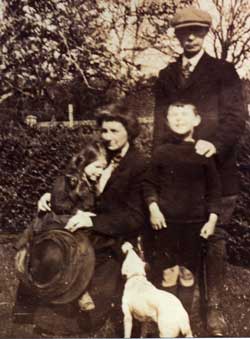
Millicent and Walter Lovelace with their daughter Elneth and their son Rex at East Farm c 1912
Walter Lovelace, his son, took on the tenancy. He was a churchwarden from 1900 until his death in 1927. After his death, the pulpit in the church was given in his memory by the people of the village. On the death of his wife Millicent, many years later, the family gave the gates and lamp arch at the entrance to the church path in her memory.

Mr Frank Woodland, carter to Mr Walter Lovelace, East Farm, 1916-1931, with an old binder. He was reported to steer a strange course on occasions (to avoid worms as he could not bear to run them over!).

Rex Lovelace with son Bill and shepherd John Randall - onetime 'stockman of the year
After his father Walter's death, Rex Lovelace, then a young man, succeeded to the tenancy of East farm. In 1942 he bought the 44 acres [17.8Ha] of Glebe land. After the Second World War he also took over the tenancy of the Manor Farm. He was for some years Chairman of the South Dorset Hunt and also Chairman of the Piddlehinton Parish Council until it merged with other parishes to form the Piddle valley Parish Council in 1977. He died in 1978.
His son Bill, who took on the tenancy, died in 1981. He and his wife Jane exchanged their tenancy for the freehold of part of the property, which she still farms today.
To qualify for a combine harvester in the war, a farm needed 400 acres [162Ha] of corn. Between Rex Lovelace at East Farm and Edgar Tory at Bourne, the requisite total was held. They arranged to share the first Massey Harris combine. It arrived in kit form from Canada for a cost of £1058 plus an extra £80 for the pick-up reel. Reg Cosh used to drive it.
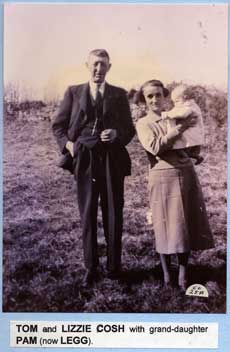
Reg's father Tom Cosh (1891-1968) was quite a character and also worked for the Lovelaces. The Cosh family has been living in Piddlehinton since at least 1820. George Cosh, aged 31 in the 1851 census, was born in Piddlehinton. Tommy Cosh fought in the First World War and served in the Home Guard in the Second World War. As well as working for Mr Lovelace, he was Sexton of the church for 30 years. There is a plaque to his memory in the church. His granddaughter and great-grandchildren live in the village.

Another of Mr Rex Lovelace's farmhands in his later years was Jack Groves (Right, with his mother and brother Walter). The Groves family lived in Piddlehinton for many years, first at Muston, where Mrs Groves (senior) worked for the Churchills. They moved to the cottage in Piddlehinton opposite the forge, by the bridge over the mill leat. This burnt down in 1925 and was never rebuilt . They found a cottage at Egypt, Piddletrenthide, later moving to Ivy House (1934). RG (Jack) Groves had fought in the 1914-18 war. He was badly burnt and spent three years in hospital. Before he enlisted, he had worked as a roadman. After the war he became a postman, cycling round the area. It was while he was on his daily rounds that their house caught fire. He continued as postman but later became a farmhand for Rex Lovelace.
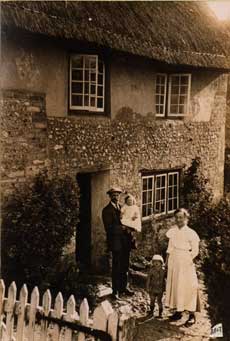
Mr and Mrs Jack Groves with daughter Nora and son Les, outside their cottage c 1922

As far as we know, Jack Groves was not related to Alfred Groves, the thatcher and hurdler.
Heave Farm (the name Heave is derived from a heap or hillock) was part of the demesne farmland. At this time it was sublet by Rex Lovelace to Cyril Green.
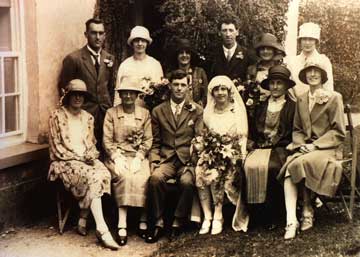
Cyril Green was born in Kingrove House, Piddletrenthide, the youngest son of gamekeeper Harry Green and his wife Harriet. On leaving school, he helped his father farm Hope Farm, Piddletrenthide, being too young to enlist to fight in the war. He married Christobel Chaldecott whose parents farmed at White Lackington. Their first home was Myrtle Cottage but they moved to Bournemouth to run a shop.
Two years later, they came back to Piddlehinton to farm. They rented the Laurels from Eton and leased Kiddles Farm from Colonel Belgrave and Higher Heave Farm as a sub-tenant, from Rex Lovelace. They also took over Hope Farm and eventually White Lackington Farm. These farms totalled 600 acres [242Ha] between them. Animals and machinery all moved between the different farms. They lived for many happy years at the Laurels, eventually buying it from Eton.
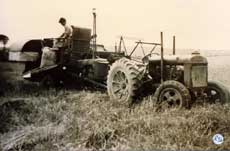

He employed local people on his farms, Percy Teversham was his dairyman and Arthur King, Herbie Trevett and the younger Ivor Spracklen also worked for him. During the war, 2 land girls joined his workforce. Cyril is seen here talking to Barbara, his Land Girl.
The upside-down tractor, rats running from the thresher, and chasing the bull are among the memories of his farming days.
.As well as running his farms, Cyril was both a Parish District Councillor, actively representing the community until shortly before his death in August 1977
Mrs Laura Dyke, with her 5 children, moved to Piddlehinton in 1908 to live in a cottage on the corner of London Row and High Street. Her husband, Albert, had worked for the brewery in Ansty until his death in 1907. Laura Dyke was in her early 40s and to support her family, she helped Parson Newman with his house cows and also helped out at Manor Farmhouse serving milk to the villagers.
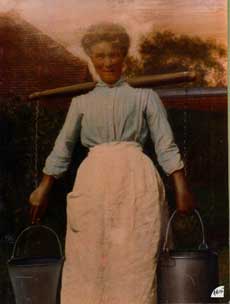
Laura Dyke

Laura Dyke in her garden overlooking Lantern Cottage where her daughter Mabel ran the Post Office and Stores.

Laura Dyke outside her cottage with granddaughter Fay
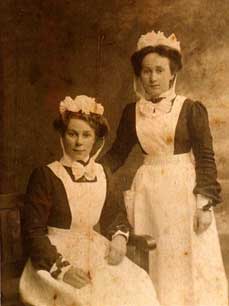
Her 2 eldest daughters, Mabel and Elsie, were originally nurses who walked to work along the unmade road to Herrison Hospital.
Mabel married Fred Gerrard and ran the Post Office and village stores. They had one son Jack.
Elsie married her cousin Ern Yeatman and moved away to Surrey. They had 2 children: Reg, who was killed in the Second World War and Laura, who often visited Piddlehinton and now lives here.
Mrs Dyke's younger children were Edward, Gussie and Florrie. Edward and Gussie went to sea. Florrie married local farmworker William Jeanes and made her home in the village with their 3 children Ted, Fay and Terry.
There were other unrelated Dyke households in the village - Charlie Dyke and his wife and daughter Muriel lived in the High Street. Their son Albert was killed in the Second World War.
Tom Jeanes Jnr was the other last farming tenant of Eton. Born on 14 May 1894 he farmed about 90 acres [36.5Ha] with his Uncle Tom Jeanes (as had his grandfather William Jeanes before him). The Jeanes family has lived in the village since John Jeanes arrived with his wife Sarah to work on the land. From the census records we know this was before 1841. The holding in 1871 was of 41 acres and 2 men and a boy were employed. They kept sheep and grew corn. The family lived at Whites Dairy House and in the dairy cottages.
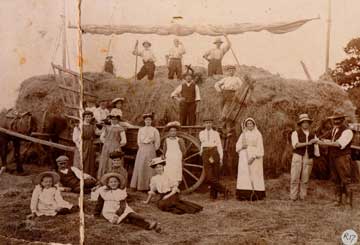
Haymaking was a family occasion in the late 19th century. This postcard was sent to Bess and showed "Uncle Tom's family, with Ern marked with a cross". Uncle Tom was the elder Tom Jeanes. Ern Yeatman, marked with a cross, lived in Surrey but came to Dorset for his holidays to visit his Aunt Laura Dyke and his cousins (one of whom, Elsie Dyke, he later married).
Tom Jeanes Jnr had two brothers and five sisters. One of his sisters, Mabel, married Bert Saint, the carpenter and funeral director. Other sisters moved away. The elder brother Walter was killed in the First World War. Younger brother William returned to work on the Manor Farm and later for Woodsford Farms.
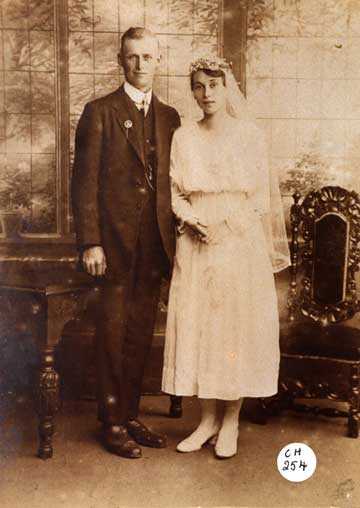
William Jeanes and Florrie Dyke (another of Laura's daughters) were married in Piddlehinton Church in 1920.

Herbie Downton on the tractor, Bill Jeanes on the binder, working for Captain Fellowes on the Manor Farm c1949
Their elder son, Ted, worked as a butcher for Wightmans in Piddletrenthide. He joined the navy during the Second World War. He died in 1965 leaving a widow and children in Dorchester. Younger son Terry and daughter Fay still live in the village and take an active part in village life. Terry was sexton at the church and captain of the bellringers. Fay was married to Geoff Lord (1932-2000), the church organist.
When his Uncle Tom died, Eton passed the tenancy down to Tom Jnr, a bachelor. Terry Jeanes and Joe Damen worked for him. He always kept a barrel of home-made cider in his barn by the churchyard, for social pleasure.

Tom Jeanes with village children including Wilf Saint, Jack Gerrard, Ted Jeanes, Doris and Alfred Barrett
Many men and boys from the village spent time helping him on his farm, as in the days of his uncle.

Harvest time, August 1949, Tom and Terry Jeanes

Tom Jeanes with Jack Gerrard on the horse
Tom Jeanes retired in 1966, the end of the Eton era! He was the last yeoman farmer to farm in the village! He died in 1978.